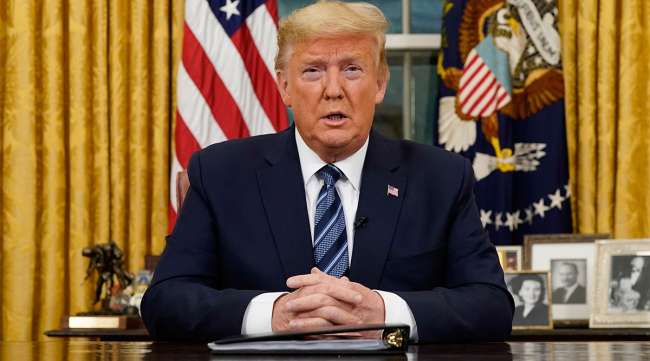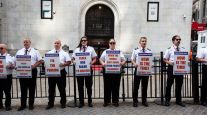Cargo Not Affected as Trump Suspends Travel From Europe to US

[Stay on top of transportation news: Get TTNews in your inbox.]
WASHINGTON — Taking drastic action March 11, President Donald Trump announced he is cutting off travel from Europe to the U.S. and moving to ease the economic cost of a viral pandemic that is roiling global financial markets and disrupting the daily lives of Americans.
Trump made the announcement that he is suspending all travel from Europe to the U.S. for 30 days beginning at 11:59 p.m. March 13 during a rare Oval Office address to the nation.
Trump said the restrictions won’t apply to the United Kingdom, and there would be exemptions for “Americans who have undergone appropriate screenings.” It also wouldn’t apply to cargo. He said the U.S. would monitor the situation to determine if travel could be reopened earlier.
After days of playing down the threat, he blamed the European Union for not acting quickly enough to address the novel coronavirus and claimed that U.S. clusters were “seeded” by European travelers.
Hoping to get the payroll tax cut approved by both Republicans and Democrats, and please remember, very important for all countries & businesses to know that trade will in no way be affected by the 30-day restriction on travel from Europe. The restriction stops people not goods. — Donald J. Trump (@realDonaldTrump) March 12, 2020
“We made a lifesaving move with early action on China,” Trump said. “Now we must take the same action with Europe.”
The mounting effort to contain the virus and financial fallout intensified on a grueling day: Communities canceled public events nationwide, universities moved to cancel in-person classes, and families grappled with the impact of disruptions to public schools. The number of confirmed cases of the infection topped 1,000 in the U.S. and the World Health Organization declared the global crisis is now a pandemic.
In a week of mixed messages and false starts, as government officials warned in increasingly urgent terms that the outbreak in the U.S. will only get worse, Washington suddenly seemed poised to act.
Congress, for its part, unveiled a multibillion-dollar aid package March 11 that was expected to be voted on by the House as soon as March 12.
“I can say we will see more cases, and things will get worse than they are right now,” Dr. Anthony Fauci, director of the National Institute of Allergy and Infectious Disease, said in testimony before the House Oversight and Reform Committee. He said the virus is “10 times more lethal than the seasonal flu.”
Trump spoke after days of confusion in Washington amid mounting calls on the president to demonstrate greater leadership. In the hours leading up to his remarks, White House aides struggled to determine what action the president could take unilaterally and what required congressional action, as Trump personally weighed the public and political reactions to the options before him.
Trump said he was also directing agencies to provide unspecified financial relief “for workers who are ill, quarantined or caring for others due to coronavirus,” and asked Congress to take action to extend it.
Trump said the U.S. will will defer tax payments for some individual and business filers for three months to lessen the impacts of the virus outbreak. He said the Small Business Administration will also make low-interest loans available to businesses to help them weather the storm.
“This is not a financial crisis,” he said. “This just a temporary moment of time that we will overcome together as a nation and as a world.”
Trump also reiterated his call on Congress to pass a cut to the federal payroll tax in order to stimulate the economy, though that proposal was dismissed by many lawmakers on both sides of the aisle. He remained silent on his previous calls to provide assistance to industries hard-hit by the pandemic, like airlines and cruise ships.
On Capitol Hill, House Speaker Nancy Pelosi unveiled an economic assistance plan that was gaining bipartisan backing. Central to the package is free coronavirus testing nationwide and emergency funding to reimburse lost paychecks for those self-quarantining, missing work or losing jobs amid the outbreak.
The draft legislation would create a new federal emergency sick leave benefit for people with the virus or caring for a coronavirus victim. It would provide two-thirds of an employee’s monthly income for up to three months.
Facing a likely surge in unemployment claims, the package would also give states money for the newly jobless. It would provide additional funding for food and nutrition benefits for pregnant women, mothers and young children. It also would free up money for “meals on wheels” and food for low-income elderly people.
Host Seth Clevenger went to CES 2020 to look at the road ahead for electric-powered commercial vehicles. He spoke with Scott Newhouse of Peterbilt and Chris Nordh of Ryder System. Hear a snippet, above, and get the full program by going to RoadSigns.TTNews.com.
The administration had floated several other strategies, including the rare idea of declaring a national disaster that could potentially unlock funding streams, according to a person unauthorized to discuss the planning and granted anonymity. But Trump ultimately opted against taking that step March 11.
A major disaster declaration provides additional authorities for federal agencies, including the military, to assist in responding to an emergency, including medical care, sheltering and distributing goods.
The administration also rolled out new recommendations for the communities most impacted by the virus in Washington state, New York and California, while authorizing Health and Human Services Secretary Alex Azar to take whatever steps necessary to increase the supply of face masks available to doctors and nurses by providing them with masks intended for industrial use.
For most people, the new coronavirus causes only mild or moderate symptoms, such as fever and cough. For some, especially older adults and people with existing health problems, it can cause more severe illness, including pneumonia.
The vast majority of people recover from the new virus. According to the World Health Organization, people with mild illness recover in about two weeks, while those with more severe illness may take three to six weeks to recover.
Congress’ attending physician told staff there could be 70 million to 100 million coronavirus cases in the U.S. That’s on par with other estimates. A Harvard official has estimated that 20% to 60% of adults will get the virus, noting it’s “a pretty wide range.”
The action @POTUS is taking to deny entry to foreign nationals who have been in coronavirus-affected areas will keep Americans safe & save lives. These are not easy decisions but they are required. I will issue guidance within 48 hours outlining details.https://t.co/KYXE7JKswC pic.twitter.com/zgi6r5FoZq — Acting Secretary Chad Wolf (@DHS_Wolf) March 12, 2020
Pelosi’s goal is to pass an aid package before lawmakers leave town for a previously scheduled weeklong recess, and revisit potential stimulus measures later.
In Washington, tourists still arrived at the U.S. Capitol, but an official unauthorized to discuss the situation and speaking on condition of anonymity confirmed that tours would soon be shut down.
Associated Press writers Lauran Neergaard, Marty Crutsinger, Laurie Kellman and Kevin Freking in Washington contributed to this report.
Want more news? Listen to today's daily briefing:





